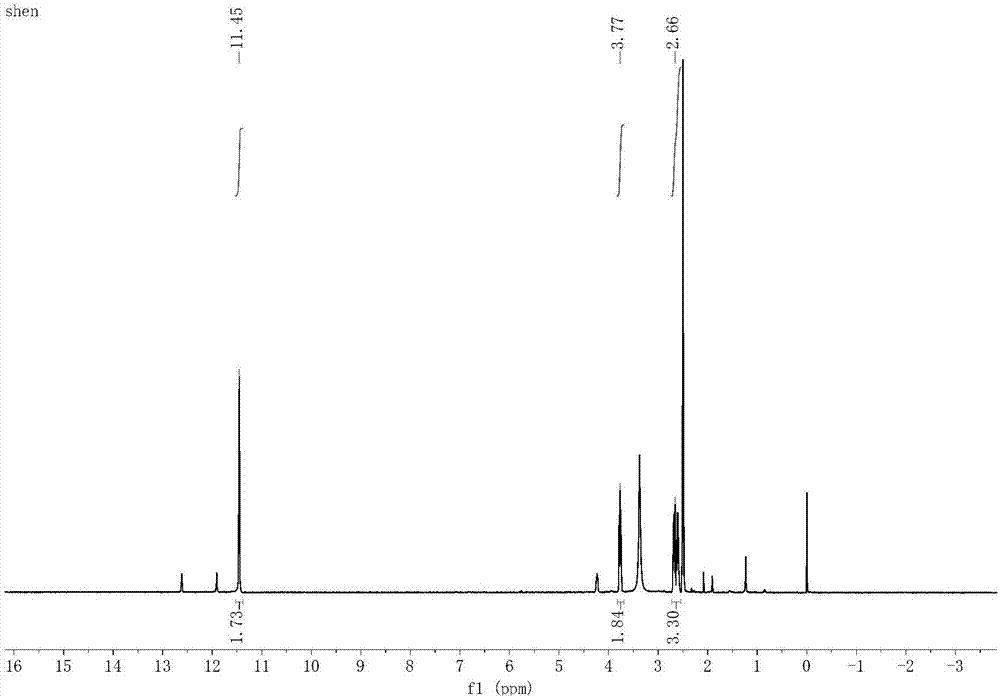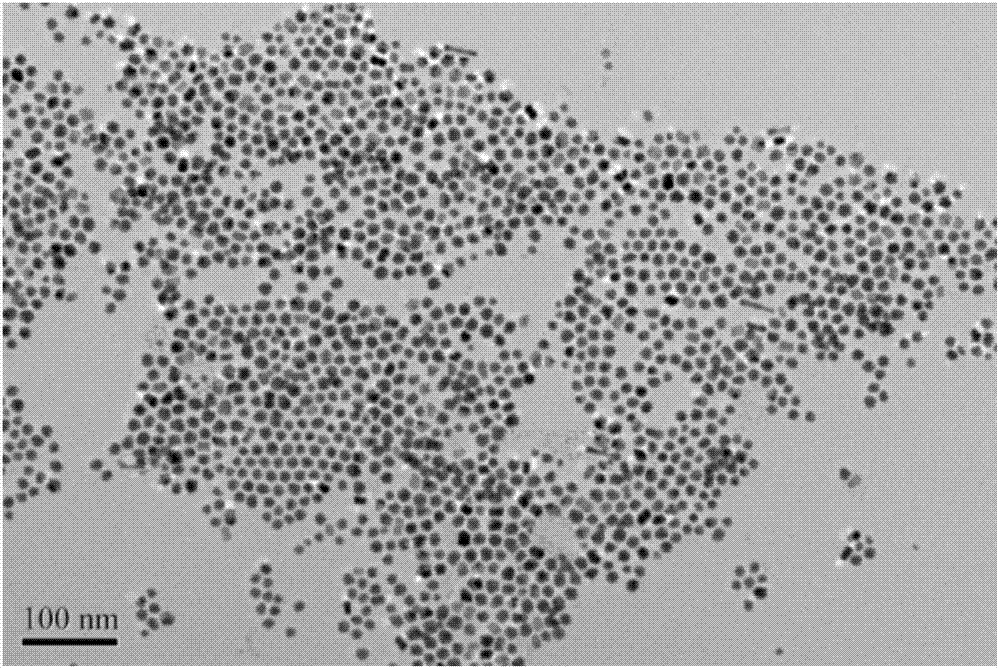based on au-fe 3 o 4 Melamine dual-mode sensor based on composite nanoparticles and its preparation
A technology of composite nanoparticles and melamine, applied in the direction of color/spectral characteristic measurement, material magnetic variable, etc., can solve problems such as urine can not be discharged smoothly, renal tubule obstruction, kidney failure, etc., to achieve shortened detection cost, high selectivity, Strong anti-interference ability
- Summary
- Abstract
- Description
- Claims
- Application Information
AI Technical Summary
Problems solved by technology
Method used
Image
Examples
Embodiment 1
[0058] (1) Preparation of specific receptor unit.
[0059] (1.1) Take 1.42 mL of ethyl isothiocyanate (12 mmol) and dissolve it in 100 mL of acetone.
[0060] (1.2) Take 1.022g of 2-amino-2-thiazoline (10mmol) and dissolve it in 200mL of CH 2 Cl 2 middle.
[0061] (1.3) The solution obtained in step (1.2) was slowly added dropwise to the solution obtained in step (1.1), and the obtained mixed solution was heated to 50° C. for 0.5 h to obtain a precipitate, filtered and washed with acetone. get
[0062] (1.4) Take 2.00g (10.7 mmol) was added to 100 mL of 18% HCl, heated to reflux for 6.5 h under argon atmosphere, and H was detected with lead acetate test paper during the reaction. 2 S, after the reaction is completed, cool, filter, and dry to obtain a white solid specific receptor unit
[0063] specific receptor unit 1 H NMR spectrum as figure 1 shown. figure 1 middle,
[0064] 1 H NMR (DMSO-d 6 ): δ=2.66(m,3,CH 2 S+SH), δ=3.77(m,2,CH 2 N), δ=11.45(s, 2, 2NH)...
Embodiment 2
[0076] (1) The preparation of the specific receptor unit is the same as that of Example 1.
[0077] (2) Au-Fe 3 O 4 The preparation of nanoparticles is the same as in Example 1.
[0078] (3) Based on Au-Fe 3 O 4 Fabrication of a dual-mode sensor for nanoparticle detection of melamine.
[0079] Take 0.1g NOBF 4 Dissolve in 10 mL DMF and dissolve by sonication. Take ~50mg Au-Fe 3 O 4 The nanoparticles were dispersed in 10 mL of n-hexane and mixed well. put NOBF 4 DMF solution added to Au-Fe 3 O 4 In the n-hexane solution of the nanoparticles, shake and shake, the nanoparticles are put into the DMF solution, and centrifuged with n-hexane and toluene (1:1). Disperse into DMF. Then 20 mg of specific receptor units were added, and the reaction was shaken on a shaker for 48 hours. Obtaining Au-Fe that modifies the acceptor unit by coordination 3 O 4 Nanoparticles in DMF solution, dialyzed for 72 hours.
[0080] The shaking time is 3-5 min.
Embodiment 3
[0082] (1) The preparation of the specific receptor unit is the same as that of Example 1.
[0083] (2) Au-Fe 3 O 4 The preparation of nanoparticles is the same as in Example 1.
[0084] (3) Based on Au-Fe 3 O 4 Fabrication of dual-mode sensor for detection of melamine by nanoparticles
[0085] Take 0.1g NOBF 4 Dissolve in 10 mL DMF and dissolve by sonication. Take ~100mg Au-Fe 3 O 4 The nanoparticles were dispersed in 10 mL of n-hexane and mixed well. put NOBF 4 DMF solution added to Au-Fe 3 O 4 In the n-hexane solution of the nanoparticles, shake and shake, the nanoparticles are put into the DMF solution, and centrifuged with n-hexane and toluene (1:1). Disperse into DMF. Then 20 mg of specific receptor units were added, and the reaction was shaken on a shaker for 24 hours. Obtaining Au-Fe that modifies the acceptor unit by coordination 3 O 4 Nanoparticles in DMF solution, dialyzed for 72 hours.
[0086] The shaking time is 3-5 min.
PUM
| Property | Measurement | Unit |
|---|---|---|
| diameter | aaaaa | aaaaa |
Abstract
Description
Claims
Application Information
 Login to View More
Login to View More - R&D
- Intellectual Property
- Life Sciences
- Materials
- Tech Scout
- Unparalleled Data Quality
- Higher Quality Content
- 60% Fewer Hallucinations
Browse by: Latest US Patents, China's latest patents, Technical Efficacy Thesaurus, Application Domain, Technology Topic, Popular Technical Reports.
© 2025 PatSnap. All rights reserved.Legal|Privacy policy|Modern Slavery Act Transparency Statement|Sitemap|About US| Contact US: help@patsnap.com



